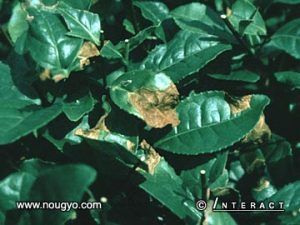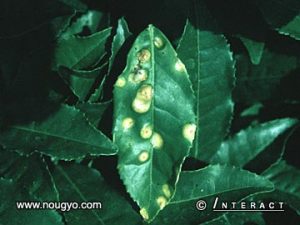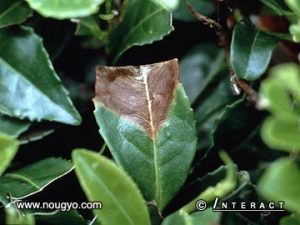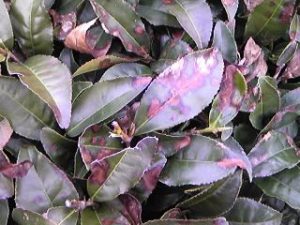In a previous post, we saw the pests of the tea plant. This time, let’s take a look at the four main diseases of the tea plant in Japan.
Anthracnose, 炭そ病 (たんそびょう), Colletotrichum theae-sinensis, Gloeosporium theae-sinensis

This fungal infection happens all over Japan, although the island of Kyushu has the most outbreaks.
It often occurs during warm weather with heavy rain. In fact, it spreads from leaf to leaf by the splashing of rain drops.
Anthracnose attacks the tea leaves only, causing brown scars.
It rarely scars the leaves at the time of harvest but the remaining ones can be severely damaged. This will have a negative impact in the quality of the next harvest.
Blister blight, もち病, Exobasidium vexans

The blister blight is called “mochi disease” in Japanese because it causes blisters that look like rice cakes (mochi).
This disease happens mostly in mountainous regions and when the humidity is high. The fungus attacks tea leaves as well as young stalks.
About a week after the blisters form, they disappear and leave a black scar.
While it has sometimes wiped out the second harvest in tea fields, it isn’t considered as severe as anthracnose because the reach of the outbreaks is limited to some regions.
Gray blight, 輪班病 (りんはんびょう), Pestalotiopsis theae, Pestalotiopsis longiseta

Both Pestalotiopsis theae and Pestalotiopsis longiseta cause this disease, but P. longiseta is more common in Japan because the Yabukita cultivar has little resistance to it.
The fungal infection happens after plucking or pruning, since it enters through the cut part of the tea plant’s leaves or stems.
It causes withering and the damage can be significant when the outbreak is large enough.
Bacterial shoot blight, 赤焼病 (あかやけびょう), Pseudomonas syringae pv. theae

As opposed to the other three diseases, this one is due to a bacteria.
The disease occurs at temperatures below 15°C (59°F), and the infection spreads if there is strong wind and rain.
Frost damage helps the outbreak, which withers the leaves and stems of the tea plant.
It is especially a problem in the prefectures of Shizuoka, Nagazaki, and Kagoshima.




